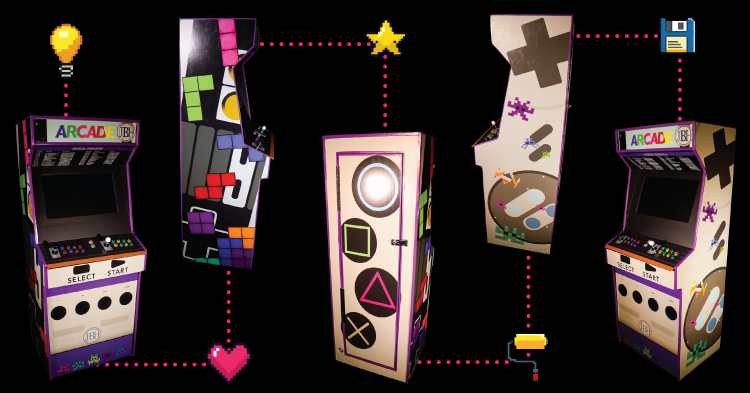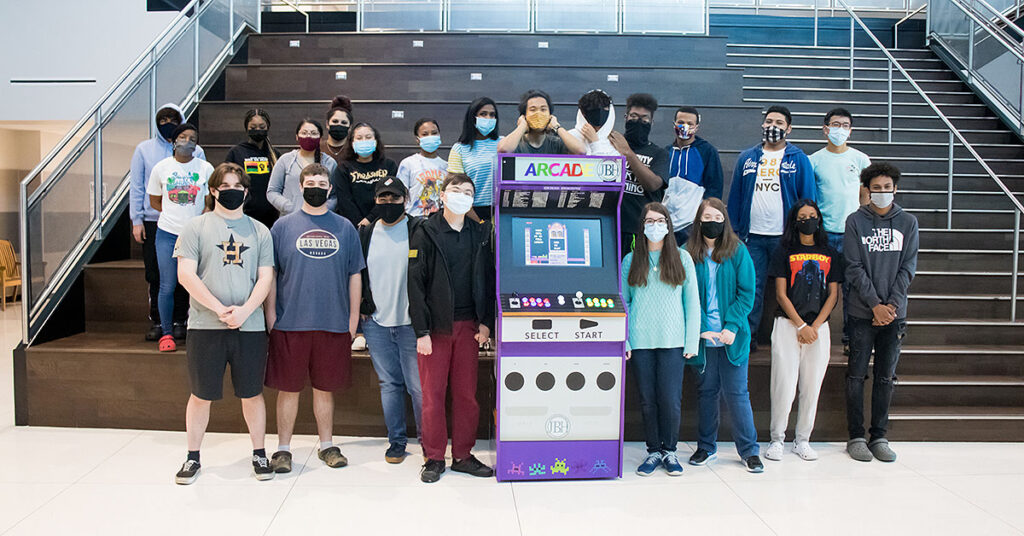Keeping It Old School: The Retro Arcade Project

Originally published in TEACH Magazine, November/December 2021 Issue
By John Burrows
Over the course of my sixteen years of teaching, I’ve taught classes in art, photography, and AV. For the last three years I’ve been running the graphic design courses at JB Hensler College and Career Academy (JBH) in Texas. I often assign projects to my students that involve designing logos, t-shirts, and stickers; illustrating scenes from books; or using posters to tell stories of their favorite vacations.
While those can be lots of fun, one of my favourite things to do is collaborate with other teachers and classes, especially of different subjects. I’ve always found that collaborating with multiple classes allows students from diverse backgrounds and varied skill sets to contribute as equals towards a meaningful and common goal.
In the past, I have organized projects with construction, cosmetology, and barbering classes, as well as with health science and vet tech students. Sometimes those projects were based around student-to-student partnerships, other times they involved collaboration between entire classes. Students have worked together to create skateboards, marketing materials and business branding, and even customized scrubs.
Some of those projects were successes and some of them were not, as occasionally collaborative projects can end up being driven by one dominant group. But they were all learning experiences and I always look forward to the next one.
Using what I had learned, I wanted to design a new project that could be more about classes working together, communicating, and listening to each other. It needed to be a project that couldn’t be dictated by any one class. Around that time, I’d been considering building a personal arcade cabinet for my own home.
When I started researching what was involved—required hardware, construction logistics, exterior design, etc.—I realized that all of the skills needed to pull this off could be found within the different subjects of study at JBH. The idea for my next collaborative (and ambitious) project was born.
Getting Started
I began by presenting my plan to the school’s principal during a casual conversation. JBH focuses on teaching our students hands-on skills so he was very enthusiastic and supportive about the project.
The next step was determining what classes should be included besides my own, graphic design. We needed to build the cabinet, so that integrated the construction class. When I shared the idea with our construction teachers, they were intrigued but needed a little more information. However, after I showed them some examples and explained their part of the project, they were all on board. I did the same thing with our computer IT teacher, knowing the computer students would be needed to do the programming for the cabinet, and it was a done deal.
Those three classes formed the base group for the project, but as things progressed we soon needed more help. That’s when we added collision repair to do the wood finishes and painting, as well as the legal studies class to make sure we were proceeding correctly. None of these classes had actively worked together on anything before but the teachers were all determined to make it happen.
The Process
Each of us presented the idea to our students and then immediately started planning. We determined what materials we needed and how much everything was going to cost. Luckily, we had almost everything that would be required onsite already.
Construction had the wood, IT had the raspberry pi (a micro-sized computer used to teach programming), and graphic design had the vinyl we were going to use. But we still had to buy several items, like the arcade buttons, wheels, memory card, and paint.
My class started discussing design ideas for the cabinet right away, and one of the initial questions that came up involved what images we could use in our designs that wouldn’t violate copyright laws. This naturally raised even more questions about what games we could legally add to the machine. Already we’d hit our first major hang-up.
Thankfully, the legal studies program at school was happy to get involved. I don’t know if you’ve ever looked into copyright law, but it is a massive subject and the students in the legal studies class jumped right into the deep end. They reached out to each group and got the build plans, what equipment the information technology class was using, and what potential designs my class was working on. And while graphic design was working with the law students, IT began meeting with the construction students to talk about the specific components of the arcade unit, to make sure that everything would fit together properly.
In one form or another, the classes talked with each other almost daily about the project, checking in, offering positive support, and working together to solve any issues that came up. Some of those issues included: how to move the cabinet, how to preserve the wood finish, and the reality that only a small selection of old games could be put on the cabinet due to legal constraints.
But once most of the problems had been addressed, the rest of the project was all about students using the skills they had been learning throughout the year to create something they were proud of. Construction built it, collision repair finished it, graphic design decorated it, and IT installed their hardware on it.
All of the classes were really pleased with the final product, and had a fun time taking pictures with the cabinet, playing its retro-style games, and taking it around the school so other classes could try it out as well. As for us teachers, we were thrilled to see our students’ hard work pay off in such a complete way.

What’s next for this project? The students are excited to try different arcade cabinet designs (they’ve already talked about trying to create a car and a table top version). And next year another school will be creating games in their computer programming class that will go on the machines we make.
Reflection
As part of our own work after the arcade cabinet was completed, the teachers interviewed students from each program to see what they thought about the project, from beginning to end. The students had nothing but positive reactions.
One statement that really stuck with me came from one of the IT students: “I loved completing this project. When they told us about the idea, I was super excited but I thought it was going to be another cool project that we start but never finish, like so many other school projects.” Another student said they really enjoyed working with students from different classes that they’d never met before and would otherwise never have gotten to interact with.
In the “real world” people from a variety of skillsets often collaborate together on projects. But in schools, students don’t usually have that opportunity. I’m so proud to have been able to offer that interdisciplinary experience for our students.
Not only did they create an incredible final product, but they demonstrated the true power of collaboration and how it can harness the unique creativity of each individual student. Although chaotic at times, all of the time and energy invested by the teachers and students really paid off and has encouraged me to continue creating these collaborative activities in the future.
This project would not have been possible without help from the following people. Thank you for your hard work to bring this collaborative experience to life: Principal Kyle Kettler, Construction teachers Larry Salinas & Sergio Cantu, IT teacher Mark Maulding, Collision Repair teacher Scott Pollard, and Legal Studies teacher Jeffrey Morrison.
John Burrows has been teaching for 16 years and is always looking for new ways to get students engaged. He strongly encourages his students to explore their own creativity and find their voice.
